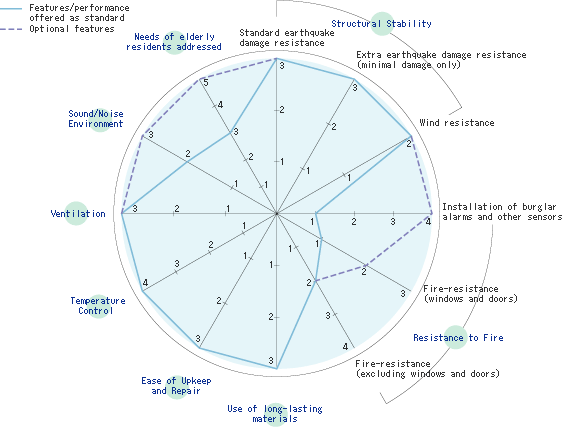 |
 |
 |
 Essential
to the Land of Earthquakes Essential
to the Land of Earthquakes
We have developed a system in which lateral force exerted by a quake is dissipated
throughout the entire house, and a unique quake-absorbing feature. In the Great
Hanshin Earthquake of 1995, which had a magnitude of 7.3, this would have reduced
the shaking to one-eighth or one-eleventh of the level experienced by residents
at the time*. This would not only alleviate the shock of an earthquake itself,
but also reduce risk of secondary accidents caused by toppling furniture or damage
to the house. As an additional benefit, we have reduced the cost of our quake-absorbing
construction system by approximately 30%.
| * |
Value based on quake simulation tests by Daiwa House Industry |
|
 |
 Becoming
Increasingly Important Becoming
Increasingly Important
The number of home break-ins in Japan has increased by a factor of 1.5 over the
past five years. With the aim of making our houses more difficult targets, we
have now developed our own unique crime-prevention specification by adopting double-glazing
(24 times as strong as single-pane windows) for all windows on the first floor,
along with a door featuring a pick-resistant lock. We have also combined a sensor
light and a video door phone. This equipment comes as standard in our single-family
house products. |
 |
 Considering
Environment in Our Daily Lives Considering
Environment in Our Daily Lives
As environmental protection has been gathering attention, we must consider the
environment in our daily lives. Daiwa House has introduced a number of initiatives
designed to save energy and conserve resources. For example, we have ensured that
our products meet next-generation energy conservation standards. This means that
our products can cut heating and air-conditioning costs by half, compared with
houses that meet the existing energy saving standard. Also, we are facilitating
the use of wind- and solar-power generation systems in our products. |
 |
 Realizing
a Healthy and Safe Environment Realizing
a Healthy and Safe Environment
At Daiwa House, we were adopting interior materials that meet the RAL standard*
of Germany, the world's highest standard, for our products even before the law
to prevent the "sick house" phenomenon was introduced. In the summer
of 2003, we took this commitment a step further and set in-house standards that
are tougher than those established under the revised Building Standard Law. We
select only the highest-grade building materials with extremely low toxic emissions
for all of our interior materials including base sheets, which are not regulated
in the Law.
| * RAL: The German Institute for Product Quality Labeling |
|
 |
 |
| *Figures indicate performance |
Living in an Aging Society
Japanese society is now aging extremely quickly, indeed at the fastest pace in
the world. The number of people aged 65 or higher accounts for one-fifth of the
total population. The population of centenarians has doubled over the past five
years. As we age, our senses and physical capabilities decline, leading to a greater
risk of accidents in the home.
The Daiwa House group has long anticipated the problems of today's aging society.
We not only established the Silver Age Research Center in 1989 but we have also
been investigating universal designs for both products and services in our Central
Research Laboratory. For example, we are researching a safe circulation line for
housework, user-friendly equipment, a full-flat floor for wheelchairs, and space
planning designed to facilitate nursing care. Our research uses our experimental
house for the elderly and our "Senior Pose"*.
| *An aging simulation system |
|
 |
City Living
Japan is increasingly witnessing a return to city center living. This has created
demand for single-family houses in urban areas. These houses must feature structure
and performance that can overcome restrictions peculiar to cities, such as limited
land, difficult natural lighting, noise, and vibration.
We have developed a shake-control technology that reduces vibration caused by
traffic, as well as a load-bearing wall boasting high earthquake resistance that
enables small land lots to be effectively utilized. In cooperation with universities,
we are also studying natural lighting that employs a top-light.
The effective use of old office buildings is another important issue. Daiwa House
is looking at converting these buildings from commercial to residential use, and
for this purpose is engaged in extensive research with the aim of developing refurbishment
and renovation technologies that meet the required standards. |
 |
Exploring the Future
We will continue to create better products and services and work towards a brighter
future for housing in Japan. In cooperation with other industries, the government
and universities, we are developing exciting technologies in a number of fields
that will enable us to realize our dream of exploring the future. These include
environmentally friendly house construction methods that conserve natural resources,
and in which waste materials are recycled as far as possible; next-generation
housing equipment that employs information and communications technology (ICT);
and the application of fuel cells to home use. |
|
 |
